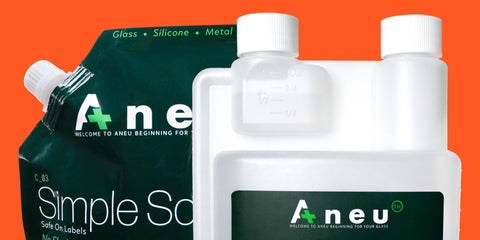High-end scientific glass bongs, prized for their aesthetic precision and functional performance, sometimes develop an unwelcome phenomenon known as “bloom.” This blog post delves into the molecular science behind bloom, why it tends to concentrate around joints and welds, and what factors—particularly those involved in assembling pieces with strong flames on a lathe—contribute to its formation. By understanding the chemistry and craftsmanship at work, glass enthusiasts and collectors can better appreciate both the challenges and the artistry involved in maintaining pristine glassware.
What Is Bloom?
“Bloom” is the term used to describe a milky-white, cloudy film that appears on the surface of glass. In the context of scientific glass bongs, bloom is most noticeable at the joints—where differently sized glass tubes are fused together. While it may appear similar to hard-water stains or smoke resin, bloom is a form of chemical weathering inherent to the glass itself. In essence, even perfectly clean glass can develop this haze over time as a result of subtle molecular changes.

The Molecular Science of Bloom
Leaching and Chemical Weathering
Borosilicate glass, the material of choice for high-end bongs, is composed of a robust silica (SiO₂) network with added oxides (such as sodium, calcium, and boron oxides) to enhance its durability. Despite its resistance, borosilicate is not completely inert. When exposed to water over time, a series of chemical reactions occur:
-
Leaching of Alkali Ions: Water molecules penetrate the glass surface at a microscopic level. They react with and slowly leach out alkali ions like sodium (Na⁺) and calcium (Ca²⁺) from the glass network.
-
Formation of Hydroxides: These freed ions combine with water to form hydroxides (NaOH, Ca(OH)₂).
-
Reaction with Carbon Dioxide: Ambient carbon dioxide (CO₂) readily reacts with these hydroxides to form carbonate compounds—most commonly sodium carbonate (Na₂CO₃) and sometimes calcium carbonate (CaCO₃).
-
Crystallization and Visible Bloom: As water evaporates during drying cycles, these carbonates crystallize on the glass surface. The resulting micro-crystalline layer scatters light, creating the characteristic frosted or hazy appearance known as bloom.
This process is a natural form of chemical weathering, and while it doesn’t usually compromise the structural integrity of the glass, it does affect clarity and visual appeal.
Why Are Joints More Susceptible?
In scientific glass bongs—often assembled on a lathe with strong flames—the design complexity and fabrication process introduce several factors that make joints particularly vulnerable to bloom:
Localized Overheating and Devitrification
-
Strong Flame Exposure: The high-intensity flames used to fuse various glass tubes can cause localized overheating at the joints. When glass is overheated, it can undergo devitrification, a process where portions of the amorphous silica structure begin to crystallize.
-
Sodium Out-Gassing: Overheating may drive sodium and other alkali components out of the glass. This “burned-out” sodium then forms a crystalline residue on the cooler adjacent surfaces—a phenomenon observed as an initial seed for bloom.
Here is a good example of devitrification from Highly Educated

Increased Surface Interfaces and Residual Stress
-
Multiple Connections: Scientific bongs often involve the connection of several tubes of different sizes. Each joint increases the overall surface area where water can interact with the glass. More interfaces mean more opportunities for water to trigger the chemical reactions leading to bloom.
-
Thermal Stress and Micro-Cracks: The process of welding glass pieces together inherently introduces thermal stress. Even with careful annealing, microscopic cracks or residual stresses may persist at the joints. These imperfections provide additional pathways for water to penetrate the glass and accelerate alkali leaching.
Uneven Drying and Water Accumulation
-
Water Trapping: The geometric complexity of joints can create pockets where water is more likely to stagnate. During evaporation, these areas become hotspots for the re-deposition of carbonate crystals.
-
Consistent Wet/Dry Cycles: Joints that are frequently exposed to water—such as those near percolators or waterlines—undergo more rapid wet/dry cycles. Each cycle reinforces the chemical weathering process, leading to a faster buildup of bloom compared to smoother, monolithic sections of glass.
Factors That Accelerate Bloom Formation
Beyond the inherent vulnerabilities at the joints, several factors contribute to the rate and severity of bloom:
-
Prolonged Water Exposure: Leaving water in the bong for extended periods or using water with high mineral content (hard water) accelerates the leaching process.
-
Improper Annealing: Insufficient or uneven cooling after welding can leave residual stresses that make the glass more prone to chemical attack.
-
Overuse of Harsh Cleaners: Strong alkaline or acidic cleaning agents can exacerbate the leaching of alkali ions, worsening bloom.
In contrast, many high-end glassmakers take meticulous care to optimize their flame settings, annealing processes, and overall craftsmanship to minimize these risks. This is why some bongs remain clear for years while others, especially those with numerous joints and aggressive flame techniques, can bloom within weeks.
Can Bloom Be Prevented or Remedied?
Prevention Through Production and Maintenance
-
Precision in Glassblowing: High-end artists aim to control flame temperature and duration, preventing localized overheating and reducing the risk of devitrification at the joints.
-
Proper Annealing: Thorough annealing relieves internal stresses and minimizes micro-crack formation, thereby reducing sites for water attack.
-
Using Distilled Water: For maintenance, using distilled water (instead of mineral-rich tap water) limits additional mineral deposition.
-
Regular Drying and Cleaning: Promptly drying glass after use (for example, with a high-purity isopropyl alcohol rinse) minimizes the wet/dry cycles that promote bloom.

Proper maintenance can have a significant effect on bloom prevention. As you can see here, these two gridline 8's were made around the same time period. However, one was owned by a very meticulous owner who diligently cleaned and maintained their piece. Where as the one on the right was owned by someone who did not properly maintain it.
Remediation Methods
-
Chemical Cleaning: Mild acids like vinegar can dissolve surface carbonates, temporarily restoring clarity.
-
Mechanical Polishing: For more persistent bloom, fine abrasives (such as cerium oxide) can be used to gently polish the surface and remove the crystalline layer.
-
Thermal Rejuvenation: In extreme cases, re-firing the glass to near its working temperature may help re-integrate the crystalline deposits back into the glass matrix. However, this method is risky and generally reserved for mid tier pieces and must be handled by professionals. If not done by someone like Fishbone or other reputable repair artists, you are not likely to get the end result you are looking for.
Conclusion
The phenomenon of bloom in scientific glass bongs is a vivid example of how advanced materials interact with their environment. At the molecular level, water leaches out alkali ions from borosilicate glass, leading to the formation of carbonate crystals that become visible as a white haze—most notably around joints where welding with strong flames introduces localized overheating, stress, and micro-cracks.
While the complex assembly of multiple glass tubes in high-end scientific bongs makes them inherently more susceptible to bloom, meticulous production techniques and careful maintenance can significantly slow its onset. Understanding the science behind bloom not only helps in appreciating the delicate balance between art and chemistry in glassblowing but also empowers users to care for their pieces more effectively.
By embracing precision in both production and everyday maintenance—using distilled water, proper cleaning, and controlled storage conditions—collectors and enthusiasts can keep their glassware as clear and stunning as the day it was crafted, despite the inevitable challenges posed by environmental exposure.
With a deeper insight into the interplay between glass chemistry and environmental factors, the art of preserving high-end scientific glass bongs becomes not just a matter of aesthetics, but a testament to the ongoing dialogue between tradition, science, and innovation in glassmaking.



